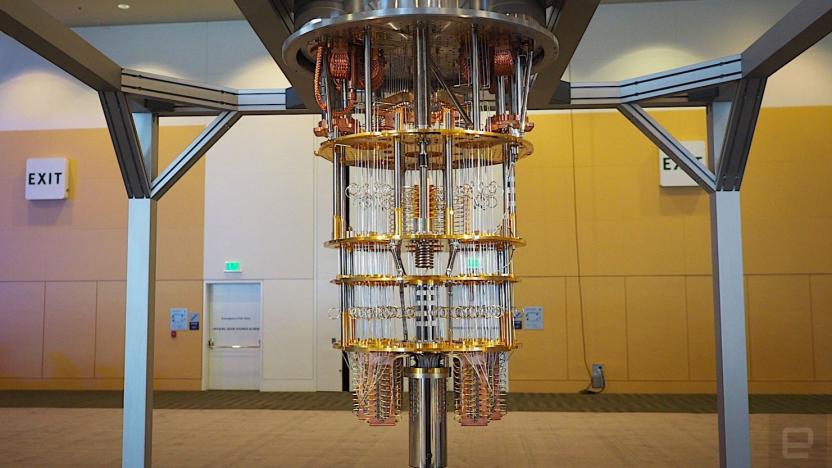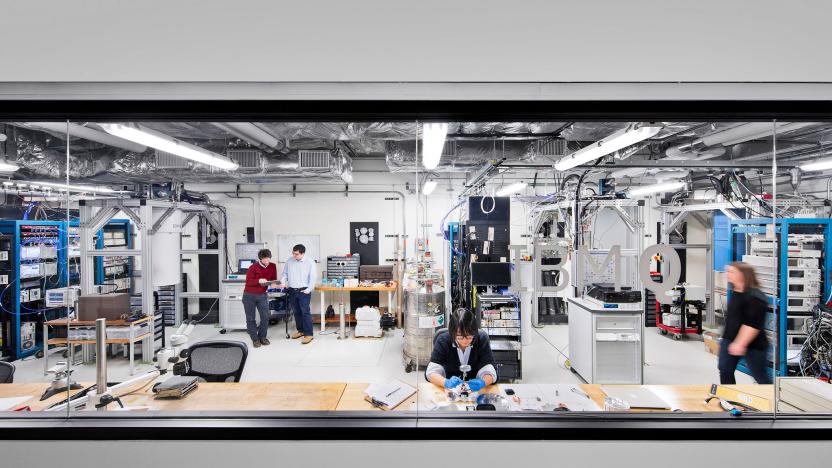ibmresearch
Latest

AI might concoct your next perfume
Perfumers look out: IBM Research partnered up with one of the top producers of flavors and fragrances, Symrise, to create an perfume-concocting AI. Named Philyra, after the Greed goddess of fragrance, it uses machine learning to sift through thousands of ingredients, formulas and industry trends to derive what IBM considers to be unique combinations. IBM is leveraging the AI to help perfumers design the next great scent rather than a machine that will replace experts of the human nose.

Not even IBM is sure where its quantum computer experiments will lead
Despite the hype and hoopla surrounding the burgeoning field of quantum computing, the technology is still in its infancy. Just a few years ago, researchers were making headlines with rudimentary machines that housed less than a dozen qubits -- the quantum version of a classical computer's binary bit. At IBM's inaugural Index Developer Conference held in San Francisco this week, the company showed off its latest prototype: a quantum computing rig housing 50 qubits, one of the most advanced machines currently in existence.

IBM unveils its most powerful quantum processor yet
IBM's two quantum computing platforms just took a leap forward in processing power. The company announced today that it has successfully built and tested its two most powerful quantum computers yet -- the research and business-focused Quantum Experience universal computer and the prototype processor that will eventually form the core of its commercial IBM Q systems.

ICYMI: Computer chips cooled by 'blood,' tiny tank and more
#fivemin-widget-blogsmith-image-392885{display:none;} .cke_show_borders #fivemin-widget-blogsmith-image-392885, #postcontentcontainer #fivemin-widget-blogsmith-image-392885{width:570px;display:block;} try{document.getElementById("fivemin-widget-blogsmith-image-392885").style.display="none";}catch(e){}Today on In Case You Missed It: IBM Research in Zurich is using fluid to both power and cool computer chips, modeled off of the way the human brain works. University of Southampton scientists created small glass discs for mega data storage that they say can survive for billions of years. A new unmanned ground vehicle that's basically a DIY tank is available for all those die-hard infantry fans. If you need your dose of nature, check out the video from a Minnesota-based YouTuber of the ice on Lake Superior breaking. As always, please share any interesting science or tech videos, anytime! Just tweet us with the #ICYMI hashtag to @mskerryd.

IBM Research and Mars tackle food safety with advanced genetics
In an effort to help prevent foodborne illnesses and contamination, IBM Research is teaming up with Mars for a safety study that'll examine how supply chains affect what we eat. Specifically, the duo will take a closer look at microorganisms in a safe factory environment to help cut down on the billions of dollars lost each year to medical costs and discarded food. By studying detailed genetics of bacteria, fungi and viruses, scientists can not only assess their growth, but also determine how to ensure our well-being when they're present. Many companies like Mars -- owner of Snickers, Uncle Ben's and other culinary brands -- already keep close tabs on quality control, but this new partnership aims to get super-specific about cataloging and analysis at an unprecedented scale.

I'm a neurotic. IBM told me so.
I'm a late Wednesday afternoon tweeter. It's not a characteristic I'd necessarily include on any of my dating app profiles, but it accurately sums up my online behavior nonetheless. I'm also a tremendous neurotic (which should come as no surprise to anyone who knows me well) who embraces self-expression, challenges and change. I'm that personality pie chart you see up above. I'm an open book, or at least my Twitter profile is to IBM.

IBM's 'Ninja Particles' could stop the rise of superbugs
IBM Research's Jim Hedrick has a great job. His work on polymers -- those repeating chains of macromolecules that make up most things in our world, like the computer or phone you're reading this on -- has led to the creation of substances with Marvel Comics-worthy descriptors. There's the self-healing, Wolverine-like substance that arose from a recycled water bottle and something called "ninja particles" that'll advance the reality of nanomedicine. Both discoveries will inevitably make their way into consumer products in the near future, but it's his team's progress on nanomedicine that Hedrick discussed during my visit to IBM Research's sprawling Almaden lab in San Jose, California.

IBM wants to kill the hard drive it invented
Saving files to memory is something that's supposed to be mostly invisible for the end user. We don't need to think about it; it just has to work. But whether it's a solid-state or hard disk drive, conventional storage solutions have their limitations -- namely, speed, rewritability and durability. A team at IBM Research's Almaden facility in California has a cure for all of that and it's called "racetrack memory."

IBM's new supercomputing chip mimics the human brain with very little power
A lot has changed in the three years since IBM first unveiled a prototype of its human brain-inspired SyNAPSE (Systems of Neuromorphic Adaptive Plastic Scalable Electronics) chip. That single-core prototype has now been significantly scaled up, leading to a new, production-ready SyNAPSE chip that blows past its predecessor with 1 million neurons, 256 million synapses and 4,096 neurosynaptic cores, all the while only requiring 70mW of power. Though the numbers are impressive, it's what they translate to that holds even greater prominence: the ability for devices to process various sensory data in parallel just like the human brain, by merging memory and computing.

How a water bottle gave birth to a whole new world of self-healing products
IBM's had a breakthrough in accelerated materials science and it's owed, in part, to a Dasani water bottle. It sounds simplistic, but the discovery of a new polymer that's not only super strong, but can also be made to be flexible and self-healing really was the happy accident of one researcher's focus on "green" chemistry and recyclable materials (i.e., plastic water bottles). Dr. Jeannette Garcia, a principal researcher for the project, was in the lab experimenting with the creation of high-performance materials when she stumbled upon this new polymer. "I made an error weighing out one of my starting materials and found that... [the new material] plugged up," she said. That resulting substance was so tightly bonded, Garcia had to smash the flask with a hammer just to get it out. She also tried hitting the substance with the hammer to see if it would break. It didn't.

IBM Research reveals new silicon chip foundation inspired by the human brain (video)
The brain is an incredibly complicated thing, so much so that scientists have spent years trying to decipher its inner workings. IBM is one such institution attempting to crack the code of the human mind. In collaboration with DARPA's SyNAPSE program, it developed a "neurosynaptic computing chip" back in 2011 designed to simulate some of the brain's functions and successfully simulated 530 billion neurons last year thanks to the world's second fastest supercomputer. Today, the company unveiled an important next step in this quest with a new software ecosystem made to program silicon chips that would closely emulate the brain's low power and compact volume. Some of the discoveries in the new ecosystem include a multi-threaded software simulator, a neuron model that supports wide-ranging neural computations, and programs made out of "corelets," building blocks that represent neurosynaptic network blueprints. It's quite a lot to grasp to be sure, so we've embedded a video after the break of IBM explaining the possible applications of its research. As for the scientifically-minded amongst you, feel free to peruse the press release for more details on IBM's latest breakthrough in cognitive computing.

IBM supercomputer simulates 530 billion neurons and a whole lot of synapses
IBM Research, in collaboration with DARPA's Systems of Neuromorphic Adaptive Plastic Scalable Electronics (SyNAPSE) program, has reached another brain simulation milestone. Powered by its new TrueNorth system on the world's second fastest supercomputer, IBM was capable of crafting a 2.084 billion neurosynaptic cores and 100 trillion synapses -- all at a speed "only" 1,542 times slower than real life. The abstract explains that this isn't a biologically realistic simulation of the human brain, but rather mathematically abstracted -- and little more dour -- versions steered towards maximizing function and minimizing cost. DARPA's SyNAPSE project aims to tie together supercomputing, neuroscience and neurotech for a future cognitive computing architecture far beyond what's running behind your PC screen at the moment. Want to know more? We've included IBM's video explanation of cognitive computing after the break.

IBM: We're on the cusp of the Quantum Computing revolution (video)
Technology's holy grail is the development of a "perfect" Quantum Computer. Traditional computers recognize information as bits: binary information representing "On" or "Off" states. A quantum computer uses qubits: operating in superposition, a qubit exists in all states simultaneously -- not just "On" or "Off," but every possible state in-between. It would theoretically be able to instantly access every piece of information at the same time, meaning that a 250 qubit computer would contain more data than there are particles in the universe. IBM thinks it's closer than ever to realizing this dream and if you want to know more, we have the full details after the break.

IBM's cognitive computing chip functions like a human brain, heralds our demise (video)
After having created a supercomputer capable of hanging with Jeopardy's finest, IBM has now taken another step toward human-like artificial intelligence, with an experimental chip designed to function like a real brain. Developed as part of a DARPA project called SyNAPSE (Systems of Neuromorphic Adaptive Plastic Scalable Electronics), IBM's so-called "neurosynaptic computing chip" features a silicon core capable of digitally replicating the brain's neurons, synapses and axons. To achieve this, researchers took a dramatic departure from the conventional von Neumann computer architecture, which links internal memory and a processor with a single data channel. This structure allows for data to be transmitted at high, but limited rates, and isn't especially power efficient -- especially for more sophisticated, scaled-up systems. Instead, IBM integrated memory directly within its processors, wedding hardware with software in a design that more closely resembles the brain's cognitive structure. This severely limits data transfer speeds, but allows the system to execute multiple processes in parallel (much like humans do), while minimizing power usage. IBM's two prototypes have already demonstrated the ability to navigate, recognize patterns and classify objects, though the long-term goal is to create a smaller, low-power chip that can analyze more complex data and, yes, learn. Scurry past the break for some videos from IBM's researchers, along with the full press release.

IBM rig doesn't look like much, scans 10 billion files in 43 minutes
Someone ought to gift these IBM researchers a better camera, because their latest General Parallel File System is a back-slapping 37 times faster than their last effort back in 2007. The rig combines ten IBM System xSeries servers with Violin Memory SSDs that hold 6.5 terabytes of metadata relating to 10 billion separate files. Every single one of those files can be analyzed and managed using policy-guided rules in under three quarters of an hour. That kind of performance might seem like overkill, but it's only just barely in step with what IBM's Doug Balog describes as a "rapidly growing, multi-zettabyte world." No prizes for guessing who their top customer is likely to be. Full details in the PR after the break.

IBM shows off Smarter Traveler traffic prediction tool
Traffic alerts on GPS devices may be old hat at this point, but there's obviously still plenty of room for improvement, and IBM now says it's managed to do just that with its new "Smarter Traveler" traffic prediction tool. Developed with the help of UC Berkeley's transportation group and the California Department of Transportation, the tool relies on predictive analytics software, GPS monitoring and sensors already on the roads to not only offer alerts, but build a model of each person's usual commuter route. Once the system is trained a bit, commuters are able to check out what's effectively a forecast of their entire route before they even leave the house, rather than simply be alerted to traffic problems before it's too late to avoid them. Head on past for the complete press release, and a quick video explanation of how it works.

IBM says graphene won't fully replace silicon in CPUs
As you may have been able to tell from the flurry of research that's occurred over the past few years (which has even resulted in a Nobel Prize), there's plenty of folks betting on graphene as the next big thing for computing. One of the big players in that respect has been IBM, which first opened up the so-called graphene bandgap and has created some of the fastest graphene transistors around, but is now sounding a slightly more cautious tone when it comes to the would-be demise of silicon-based CPUs. Speaking with Custom PC, IBM researcher Yu-Ming Lin said that "graphene as it is will not replace the role of silicon in the digital computing regime," and further explained that "there is an important distinction between the graphene transistors that we demonstrated, and the transistors used in a CPU." To that end, he notes that unlike silicon, "graphene does not have an energy gap," and that it therefore cannot be completely "switched off," which puts it at quite a disadvantage compared to silicon. Intel's director of components research, Mike Mayberry, also chimed in on the matter, and noted that "the industry has so much experience with it that there are no plans to move away from silicon as the substrate for chips." That doesn't mean that there still isn't a bright future for graphene, though -- Lin gives the example of hybrid circuit, for instance, which could use graphene as a complement to silicon in order to "enrich the functionality of computer chips."

IBM demonstrates 100GHz graphene transistor
It's just been a little over a week since IBM researchers announced that they managed to open up a bandgap for graphene-based field-effect transistors, but they're now already back to show off what that's made possible: a 100GHz graphene transistor. What's more, this latest record-setting transistor (which IBM hopes will one day replace silicon transistors) was made using processing technology that's compatible with that currently used in advanced silicon device fabrication, which should no doubt help speed up its eventual commercialization. Of course, any widespread adoption is still quite a ways away, but IBM says that this new transistor "demonstrates clearly that graphene can be utilized to produce high performance devices and integrated circuits." For those keeping score, this first-of-its-kind transistor already beats the frequency performance of current state-of-the-art silicon transistors of the same gate length, which now top out at a mere 40GHz.









